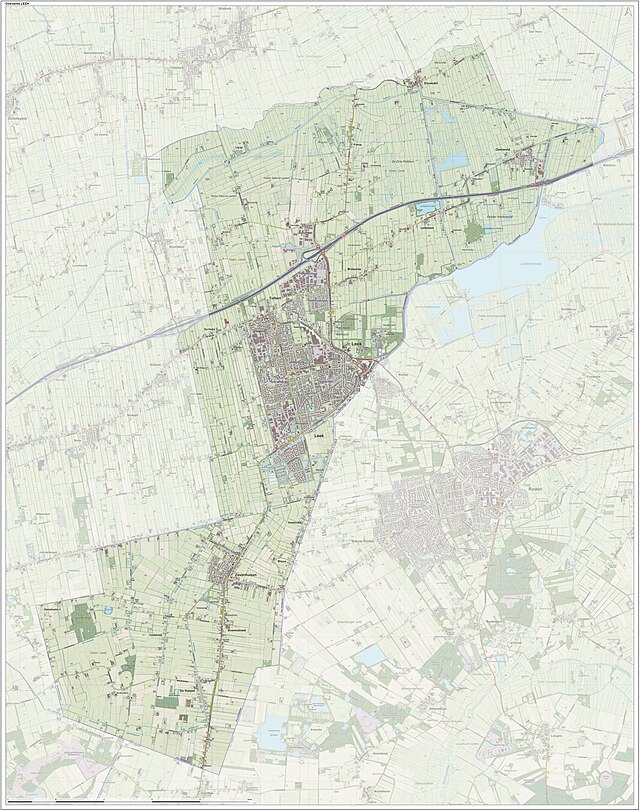Leek, Netherlands
Town and former municipality in Groningen, Netherlands From Wikipedia, the free encyclopedia
Town and former municipality in Groningen, Netherlands From Wikipedia, the free encyclopedia
Leek (Dutch: [leːk] ; Gronings: De Laik; West Frisian: De Like) is a village and former municipality in Groningen province in the northeastern Netherlands. The municipality, which bordered the Drenthe and Friesland provinces, was merged into the municipality of Westerkwartier on 1 January 2019.[4]
Leek
| |
|---|---|
Town and former municipality | |
 Nienoord castle | |
 Location in Groningen | |
| Coordinates: 53°10′N 6°23′E | |
| Country | |
| Province | |
| Municipality | |
| Merged | 2019 |
| Area | |
| • Total | 6.17 km2 (2.38 sq mi) |
| Elevation | 2 m (7 ft) |
| Population (2021)[1] | |
| • Total | 11,175 |
| • Density | 1,800/km2 (4,700/sq mi) |
| Demonym | Leekster |
| Time zone | UTC+1 (CET) |
| • Summer (DST) | UTC+2 (CEST) |
| Postcode | 9350–9351[1] |
| Area code | 0594[3] |

The village of Leek is approximately 20 km west of Groningen (city) on the A7 (E22) highway.
The village grew around a fortification that was constructed during the Eighty Years' War with Spain. The name 'Leek' was derived from a brook, the "Leke". The town is sometimes also called "De Leek". In Dutch, the people from Leek are called "Leeksters".
Every year around Pentecost there is a fair (Pinkstermarkt), drawing thousands of people from the area.
Near the village is a shallow lake, the Leekstermeer (also known as Zulthermeer), with recreational facilities, but the lake is in another municipality and in another province.
The main attraction in the village is the "Nienoord" estate. The estate was founded in 1508. After a destroying fire, a new manor-house was built in 1887. The gardens and the shell grotto were restored.
The National Carriage Museum is located in this manor-house. In 1958 the National Carriage Museum rented the house and gardens. The National Carriage Museum presents an overall view of the various types of carriages and sleighs from the 18th to the 20th century. The 250 coaches in the museum's collection were used by farmers, the common man, noblemen and royalty.
In the estate is situated a recreation park (Family-park Nienoord) with model railways in several scales, including live steam.
In Tolbert and Midwolde are churches from the 12th century. The churches are built in the Romano-Gothic style. Typical for this style are the walls and gables of brick that are richly decorated with recesses and patterns of bricks.
In the church of Midwolde is a tomb monument sculpted by Rombout Verhulst. Rombout Verhulst also decorated the tomb of Michiel de Ruyter in the Nieuwe Kerk in Amsterdam.
Enumatil, Leek, Lettelbert, Midwolde, Oostwold, Tolbert and Zevenhuizen.
Seamless Wikipedia browsing. On steroids.
Every time you click a link to Wikipedia, Wiktionary or Wikiquote in your browser's search results, it will show the modern Wikiwand interface.
Wikiwand extension is a five stars, simple, with minimum permission required to keep your browsing private, safe and transparent.